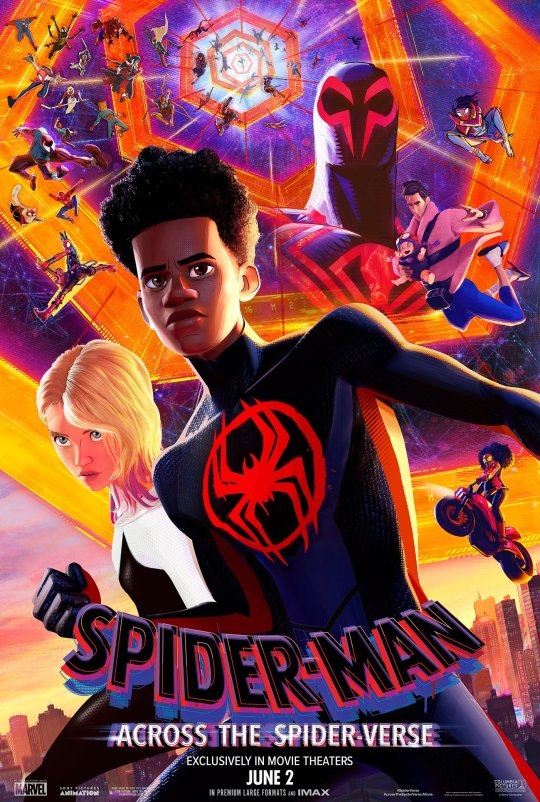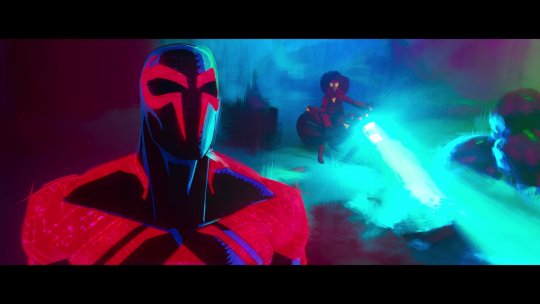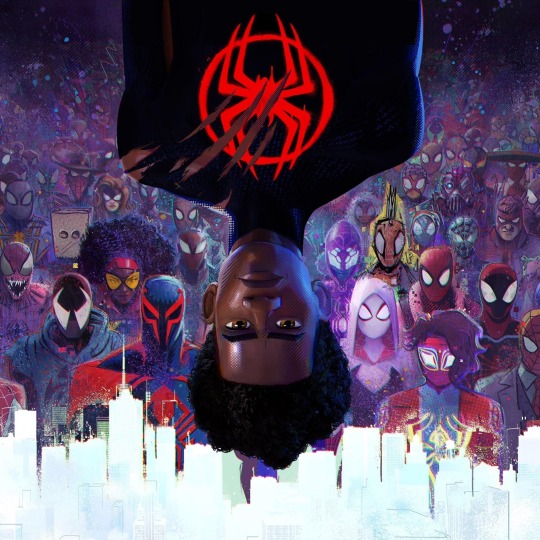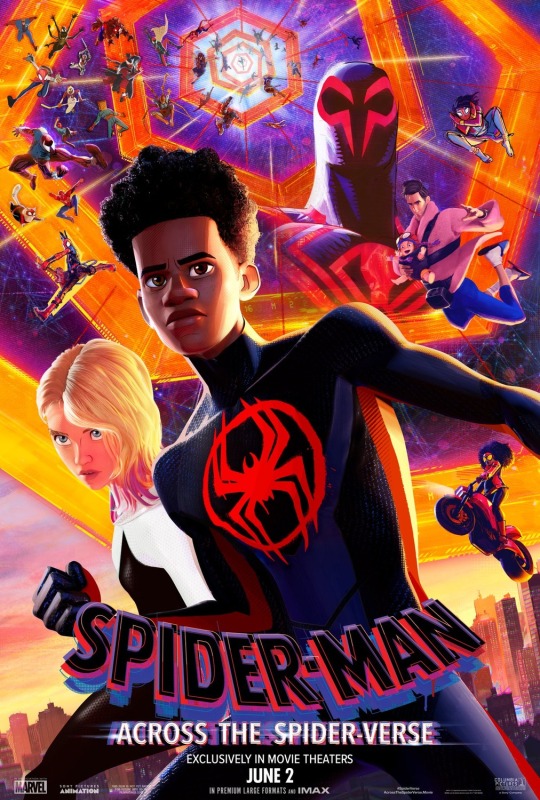#oscar dos santos
Photo

Films Watched in 2023:
55. Spider-Man: Across the Spider-Verse (2023) - Dir. Joaquim Dos Santos/Justin K. Thompson/Kemp Powers
#Spider-Man: Across the Spider-Verse#Joaquim Dos Santos#Justin K. Thompson#Kemp Powers#Shameik Moore#Hailee Steinfeld#Oscar Isaac#Brian Tyree Henry#Luna Lauren Velez#Jake Johnson#Jason Schwartzman#Daniel Kaluuya#Issa Rae#Karan Soni#Shea Whigham#Greta Lee#Mahershala Ali#Andy Samberg#Amandla Stenberg#Jharrel Jerome#Jack Quaid#Donald Glover#Spider-Man#Marvel#Films Watched in 2023#My Post
25 notes
·
View notes
Photo

Everyone keeps telling me how my story is supposed to go
Spider-Man: Across the Spider-Verse, Joaquim Dos Santos, Kemp Powers and Justin K. Thompson (2023)
#Joaquim Dos Santos#Kemp Powers#Justin K. Thompson#Phil Lord#Christopher Miller#Dave Callaham#Shameik Moore#Hailee Steinfeld#Brian Tyree Henry#Luna Lauren Velez#Jake Johnson#Oscar Isaac#Jason Schwartzman#Issa Rae#Daniel Kaluuya#Karan Soni#Shea Whigham#Greta Lee#Mahershala Ali#Amandla Stenberg#Daniel Pemberton#Mike Andrews#2023
21 notes
·
View notes
Photo





#Spider-Man: Across the Spider-Verse#Joaquim Dos Santos#Justin K. Thompson#Kemp Powers#Shameik Moore#Hailee Steinfeld#Jake Johnson#Oscar Isaac#2023
30 notes
·
View notes
Text



Spider-Man: Across the Spider-Verse
2023. Animated Superhero film
By Joaquim Dos Santos, Kemp Powers & Justin K. Thompson
Starring (voices): Shameik Moore, Hailee Steinfeld, Brian Tyree Henry, Lauren Vélez, Jake Johnson, Jason Schwartzman, Issa Rae, Karan Soni, Shea Whigham, Greta Lee, Daniel Kaluuya, Mahershala Ali, Oscar Isaac...
Country: United States
Language: English
#Spider-Man: Across the Spider-Verse#Shameik Moore#Hailee Steinfeld#Brian Tyree Henry#Lauren Vélez#Jake Johnson#Jason Schwartzman#Issa Rae#Karan Soni#Shea Whigham#Greta Lee#Daniel Kaluuya#Mahershala Ali#Oscar Isaac#Joaquim Dos Santos#Kemp Powers#Justin K. Thompson#United States#English#2023#2020s#Animation#Superhero
6 notes
·
View notes
Text
Spider-Man: Across the Spider-Verse (2023) Review
With great power comes great responsibility – and Spider-Man: Across the Spider-Verse powerfully proves that animated superhero movies can deliver on both fronts. #Review

View On WordPress
#2023#animation#brian tyree henry#daniel kaluuya#hailee steinfeld#issa rae#jake johnson#jason schwartzman#joaquim dos santos#justin k thompson#karan soni#kemp powers#luna lauren velez#mahershala ali#marvel#oscar isaac#shameik moore#spider-man#superhero
5 notes
·
View notes
Text

#Spider-Man: Across the Spider-Verse#Shameik Moore#Hailee Steinfeld#Brian Tyree Henry#Lauren Vélez#Jake Johnson#Jason Schwartzman#Issa Rae#Karan Soni#Shea Whigham#Greta Lee#Daniel Kaluuya#Mahershala Ali#Oscar Isaac#Joaquim Dos Santos#Kemp Powers#Justin K. Thompson#2023
4 notes
·
View notes
Text
WATCHLIST 2023: Spider-Man: Across the Spider-Verse







#Spider-Man: Across the Spider-Verse#movie watchlist#hailee steinfeld#oscar isaac#jason schwartzman#daniel kaluuya#shameik moore#Karan Soni#luna lauren velez#brian tyree henry#issa rae#andy samberg#Jharrel Jerome#shea whigham#Joaquim Dos Santos#Justin K. Thompson#Kemp Powers
6 notes
·
View notes
Video
youtube
Spider-Man: Across the Spider-Verse Trailer
“After reuniting with Gwen Stacy, Brooklyn’s full-time, friendly neighborhood Spider-Man is catapulted across the Multiverse, where he encounters a team of Spider-People charged with protecting its very existence. But when the heroes clash on how to handle a new threat, Miles finds himself pitted against the other Spiders and must redefine what it means to be a hero so he can save the people he loves most.” (Sony Pictures Entertainment)
Spider-Man: Across the Spider-Verse stars the voice talents of Shameik Moore, Hailee Steinfeld, Jake Johnson, Issa Rae, Daniel Kaluuya, Jason Schwartzman, Brian Tyree Henry, Luna Lauren Valez, Greta Lee, Rachel Dratch, Jorma Taccone, Shea Whigham, and Oscar Isaac. The film is directed by Joaquim Dos Santos, Kemp Powers, and Justin K. Thomspon from a screenplay by Phil Lord, Christopher Miller, and David Callaham.
Spider-Man: Across the Spider-Verse releases to theaters on June 2, 2023.
#spider-man#spider-man across the spider-verse#miles morales#gwen stacy#marvel#sony pictures#shameik moore#hailee steinfeld#oscar isaac#joaquim dos santos#kemp powers#justin k thompson#phil lord#christopher miller#david callaham#TGCLiz
8 notes
·
View notes
Photo

Spider-Man: Across the Spider-Verse (2023)
When Columbia and Sony Pictures Animation released Spider-Man: Into the Spider-Verse in late 2018, the film’s daring visual style brought the art of a comic book to life. For a major American studio that had arguably the thinnest track record in terms of animated features and shorts (yes, I am counting Columbia’s association with UPA), it was a stunning achievement. And it appears its visual influence is only beginning to ripple across cinema, if The Mitchells vs. the Machines (2021) and Puss in Boots: The Last Wish (2022) are any indication. Directed by Joaquim Dos Santos, Kemp Powers, and Justin K. Thompson, Spider-Man: Across the Spider-Verse cannot hope to match the first impressions of five years ago, but what a hell of an impression it leaves. Visually, it exceeds its predecessor, but, due to the necessity of its heavily expository multiverse-based screenplay (this film is first part of two), it is the weaker of the extant Miles Morales Spider-Verse movies. When considering the bar set by the previous film, ATSV remains one of the finest superhero films ever made.
Sixteen months after the events of ITSV, Gwen Stacy (Hailee Steinfeld) must contend with the situation that she must keep secret her Spider-Woman identity while her policeman father (Shea Whigham) hunts Spider-Woman down. An incident concerning a villain from a different universe introduces her to the Spider-Society – a group of Spider-People from thousands of universes who assist each other, as well as maintaining the space-time order of their respective universes. Earth-1610 is Miles Morales’ (Shameik Moore) world. There, Miles is still pining for Gwen, as the college admissions process draws near and his parents, concerned about his grades, ask for a conference with the counselor. But the mysterious appearance of The Spot (Jason Schwartzman) seems to be Miles’ more immediate concern. Gwen arrives on Earth-1610 not necessarily to see Miles, but to monitor the Spot’s movements. Miles, not invited to the Spider-Society, falls into the group and learns more about “canon events” and the manner in which he became Spider-Man.
Brian Tyree Henry and Luna Lauren Vélez reprise their roles of Miles’ parents, as does Jake Johnson as Peter B. Parker. Issa Rae, Karan Soni, Daniel Kaluuya, and Oscar Isaac play other prominent Spider-People in this film. The cameos from across Spider-Man media are too numerous to list here.
Phil Lord and Christopher Miller (2009’s Cloudy with a Chance of Meatballs, 2014’s The Lego Movie) and Dave Callaham’s (2010’s The Expendables, 2020’s Wonder Woman 1984) screenplay is hamstrung by the very fact that this film has no resolution. Because this is by design, I will hold most of my fire. However, the pile-up of subplots – Gwen’s relationship with her father, Miles’ relationship with his parents and him missing his late uncle, his developing relationships with the other Spider-People, a reveal that throws into question Miles’ self-belief he is a worthy Spider-Person, Peter B. Parker’s newfound fatherhood and relationship with Mary Jane Watson, tensions between the leader of the Spider-Society and Gwen, etc. – is overflowing, uncontainable, and impossible to treat each one with the developmental (because I understand that not all of these can be resolved yet) respect they deserve. The appeal of Spider-Man is rooted deeply in the ordinariness and day-to-day struggles of whoever dons the suit. Not the spider powers, not the villains, not the multiverse shenanigans, not the humor (of which there is plenty, don’t worry). Those multiverse shenanigans overshadow most of the movie. Only during Gwen’s scenes with her father (ATSV’s strongest moments) and Miles at the very beginning and in the closing chapters of this film does the viewer ever feel the pull of those central Spider-Man themes.
Miles, this series’ primary star, must reckon with the realization that his becoming Spider-Man was a multiverse-related accident, rather than what constitutes as the “normal” way to become Spider-Man – you know, being bit by a spider that came from your universe instead. Through Miles, Lord, Miller, and Callaham are clearly attempting to establish a message that one should reject determinism and wrest control of one’s future for themselves. For me, the execution of that messaging relies too heavily on the metatextual elements related to Spider-Man lore to be as resonant in the first movie, when Miles was addressing more grounded personal problems. But Shameik Moore mostly sells Miles’ doubts in another solid voice acting turn, especially when confronted with the most disapproving of the Spider-People.
Far more effective are Gwen’s troubles with her police captain father. In their universe, her father is undertaking a zealous campaign to find and bring Spider-Woman to justice in the belief that Spider-Woman murdered Gwen’s friend, Peter Parker. Meanwhile, Gwen – living a sort of second life she hides from her father, is beginning to become more emotionally distant from him, and (like Miles) is having difficulty finding a place in her world. The tension-filled scenes between daughter and father, recalling the first issues of the Spider-Gwen series, raise the questions of morality and responsibility that Spider-Man lore is known for. As such, they are the emotional highlights of ATSV – lifting Gwen almost to a co-lead in this movie, and enlivening her storyline beyond her infamous and still-controversial deaths in the mainline Spider-Man comic series and The Amazing Spider-Man film series (2012-2014).
The cutting-edge animation of 2018’s Into the Spider-Verse was breathtaking. For Across the Spider-Verse, the variety of styles somehow make the preceding film look safe by comparison. The multiplicity of styles in ATSV truly allows the viewer to inhabit the idea of a multiverse – better than any multiverse-centric offering Disney’s Marvel Cinematic Universe (MCU) has to offer, and perhaps more convincingly than The Daniels’ Everything Everywhere All At Once (2022; although that movie worked wonders on a fraction of ATSV’s budget). The company logos for Sony, Columbia, and Marvel – flickering in stylized fashion and, in Columbia’s case, brief glimpses of older renditions – provide only the first hint of the animated radicalism to come. Like ITSV, ATSV is also a CGI movie that exemplifies a remarkable fidelity to certain aspects of traditional hand-drawn animation – see character designs and movements. Including blink-and-you’ll-miss-it footnotes during bits of unfamiliar dialogue are a cheeky touch. The fluidity and clarity in which characters move through space during action sequences far surpasses the choreographic incoherence that is endemic in recent MCU films. ATSV takes the very best of comic book and graphic novel artistry and translates that beautifully on the big screen.
Let us take the best-case example in the film. As Gwen’s universe contains the most appealing subplot of the film, so too is it the most aesthetically interesting. ATSV may be a computer-animated film, but Gwen’s Earth-65 appears as impressionist brushstrokes. Gwen, her father, and all those who inhabit that Earth, are animated similarly to those in Miles’ universe. The major difference is the backgrounds. With shades, gradients, brushstrokes, dots, and splashes of off-whites, pinks, and blues, the backgrounds change with each cut – reflecting the direction and moods of a conversation or an action scene. As the dramatic intensity of a conversation increases, the more abstract the backgrounds look. These background changes are but a suggestion; Gwen and her father do not see the dazzling colors flying around and behind them. It is thrillingly experimental stuff for a major Hollywood studio animated work.
Some viewers of ATSV have interpreted Gwen’s story as a transgender allegory (at the very least). The presence, above her room’s door head, of a transgender flag reading “protect trans kids” has fueled further speculation – and bans from cinemas in Saudi Arabia and the United Arab Emirates – that Gwen herself might be transgender. Her universe is emblazoned with the trans flag colors (the whites/off-whites, pinks, and blues mentioned earlier), and the language she employs in her final conversation with her father in this film almost sounds like a coming out. No matter how one interprets this aspect (and there is nothing in the film to prevent one from interpreting her scenes allegorically or literally), it is the finest reinforcement of one of the film’s central theses: that anyone, regardless of gender identity, race, religion, or sexual orientation can be a Spider-Person.
youtube
Like ITSV, much of ATSV’s soundtrack comprises of numerous hip hop songs that are used not so much to complement what is occurring on-screen, but to instead serve as background vibe noise, lyrics barely discernible. This musical direction goes against my beliefs that original and non-original film music have an expressive power. To mute such music so consistently is to deny an opportunity to enhance the expressivity of both the motion picture and music. It just becomes sonic wallpaper, there only to sell soundtracks and pump up music streaming numbers. Either cut the songs or be more selective of the placement of these non-original songs.
Elsewhere, composer Daniel Pemberton’s (2015’s The Man from U.N.C.L.E., 2020’s Enola Holmes) score for ITSV was riddled with heavy-handed electronic manipulation and record scratching, with nary any acoustic elements. Pemberton’s background is in avant-garde electronic music. Appropriate, perhaps, for Miles’ Brooklyn soundscape, but it is deeply unpleasant to listen to outside of the film’s context. With the universe-jumping of ATSV, one musical mode cannot serve the entire film. Gwen’s universe opens with understated, ethereal synth in “Spider-Woman (Gwen Stacy)”. Unfortunately, the musical ideas of Gwen’s universe are never quoted as wonderfully again. Reintroducing Miles and opening his storyline in ATSV is “My Name Is… Miles Morales”, which utilizes Latin American rhythmic complexities in its unmanipulated percussion – already a notable departure from ITSV – alongside Miles’ three-note motif (“SPI-der-MAN!”) from the first film. The traditional orchestra has a larger presence in ATSV, perhaps due to Pemberton’s success in his predominantly orchestral score to Enola Holmes. “Nueva York Train Chase” is one of the major beneficiaries of that orchestral integration. The cue’s thrilling string runs accompany the action magnificently and, combined with enormous hits in the bass brass in the climactic moments, is one of the best action cues in superhero film scoring in some time. Pemberton still resorts to many of his worst habits in his excessive manipulation, but this is a far better score than ITSV’s.
As this write-up heads towards publication, the Writers Guild of America (WGA) is on strike with the Screen Actors Guild-American Federation of Television and Radio Artists (SAG-AFTRA) perhaps soon to follow. Labor practices in Hollywood are under scrutiny as streaming and artificial intelligence (AI) pose to change how studios make movies. Though Sony Pictures Animation is covered under The Animation Guild (TAG), there are reports that artistic input from co-screenwriters and co-producer Phil Lord and Christopher Miller have engendered an unsustainable and unhealthy working environment. Lord and Miller, in their capacity as producers, have a reputation in the animation industry for coming onboard as producers late in production and forcing animators to partake in wide-ranging changes on complete or near-complete work. Their laborious revisionism, say some of ATSV’s animators, comes without a set artistic vision – it is trial-and-error for the sake of it.
In American animation, considerable artistic changes during production are commonplace, but they often take place early on, most typically during storyboarding. Any changes coming later than the storyboarding stage can be a financial boondoggle for a studio and can result in a chaotic animating process. If these anecdotes are true, Lord and Miller are responsible for the film’s high turnover rates and widespread burnout. This behavior should prove incentive for the artists at Sony Pictures Imageworks – despite sharing a corporate parent with Sony Pictures Animation, Vancouver-based SPI is non-unionized and worked on all the physical animation on ITSV and ATSV – to unionize. Scheduled for a March 2024 release, Spider-Man: Beyond the Spider-Verse, due to the alleged aforementioned issues surrounding Lord and Miller, may not be ready in time for its slated debut.
A thunderbolt of animated innovation, Spider-Man: Across the Spider-Verse’s true value will be unknown until Beyond the Spider-Verse’s release. Fast-paced and overstuffed to a fault, ATSV might not have the freshness that ITSV brought. But for a major American animated studio in the early 2020s, this is bewilderingly wonderful work. One just wonders what the animators possibly could have left up their sleeves.
My rating: 9/10
^ Based on my personal imdb rating. My interpretation of that ratings system can be found in the “Ratings system” page on my blog. Half-points are always rounded down.
For more of my reviews tagged “My Movie Odyssey”, check out the tag of the same name on my blog.
#Spider-Man#Spiderman#Across the Spider-Verse#ATSV#Joaquim Dos Santos#Kemp Powers#Justin K. Thompson#Phil Lord#Christopher Miller#Dave Callaham#Shameik Moore#Hailee Steinfeld#Brian Tyree Henry#Luna Lauren Vélez#Jason Schwartzman#Issa Rae#Daniel Kaluuya#Oscar Isaac#Daniel Pemberton#My Movie Odyssey
4 notes
·
View notes
Text
Spider-Man: Across The Spider-Verse. First Impressions.
Even from the perspective of an animation fan having seen every major US theatrical offering in its first run for the past 20 years, it’s hard to underestimate what an instant impact Spider-Man: Into The Spider-Verse had. Lord and Miller plus their creative teams had of course laid the groundwork with their work on The Lego Movie and its popularization of the 2.5 D animation style ( technical…

View On WordPress
#Amandla Stenberg#Andy Samberg#Brian Tyree Henry#Christopher Miller#Daniel Kaluuya#Hailee Steinfeld#Issa Rae#Jack Quaid#Jake Johnson#Jason Schwartzman#Joaquim Dos Santos#Justin K. Thompson#Karan Soni#Kemp Powers#Luna Lauren Velez#Oscar Isaac#Phil Lord#Shameik Moore#Shea Whigham
2 notes
·
View notes
Text
Masterpiece.
#movie review#letterboxd#spider man: across the spider verse#spider-man#shameik moore#hailee steinfeld#oscar isaac#daniel kaluuya#karan soni#brian tyree henry#miles morales#joaquim dos santos#kemp powers#Justin k Thompson#phil lord#chris miller#david callaham
3 notes
·
View notes
Text
Are you as excited for Across the Spider-Verse as we are?! What character are you most looking forward to seeing again? Which type of Spidey do you wanna see? Let us know in the comments and check out our thoughts on the first teaser in episode 222!
#creative differences#podcast#spider man#across the spiderverse#spider man: across the spider verse#miles morales#gwen stacy#shameik moore#hailee steinfeld#jake johnson#issa rae#oscar issac#luna lauren velez#daniel kaluuya#joaquim dos santos#kemp powers#Justin k Thompson#phil lord#christopher miller
5 notes
·
View notes
Text

#17: Spider-Man: Across the Spider-Verse (2023, dir. by Joaquim Dos Santos, Kemp Powers, Justin K. Thompson)
#spider-man: across the spider-verse#movies of 2024#movie poster#joaquim dos santos#kemp powers#justin k. thompson#oscars
1 note
·
View note
Text
Reseña | 'Spider-Man: A Través del Spider-Verso'
Superando en escala a su antecesora, A través del Spider-Verso es una de las mejores películas del arácnido.
Desdes sus inicios, uno de los efectos más poderosos y emocionantes del cine sobre la audiencia es su capacidad de sorprender. Ya sea mostrando la llegada de un tren, o por medio de una deslumbrante presentación de planetas inimaginables, el cine ha logrado robar las palabras del espectador en más de una ocasión.
Sin embargo, con el paso de los años, y con la evolución de la tecnología, y la…

View On WordPress
#Bryan Tyree Henry#Christopher Miller#Daniel Kaluuya#Hailee Steinfeld#Issa Rae#Jake Johnson#Jason Schwartzman#Joaquim Dos Santos#Justin K. Thompson#Kemp Powers#Oscar Isaac#Phil Lord#Shameik Moore#Spider-Man#Spider-Man: Across the Spider-Verse
1 note
·
View note
Text
'Spider-Man: Across the Spider-Verse' Keeps Running Right Through Every Iteration
'Spider-Man: Across the Spider-Verse' Keeps Running Right Through Every Iteration
Tonight, we’re gonna Spider like it’s 2099 (CREDIT: Sony Pictures)
Starring: Shameik Moore, Hailee Steinfeld, Oscar Isaac, Brian Tyree Henry, Luna Lauren Velez, Jake Johnson, Jason Schwartzman, Issa Rae, Karan Soni, Daniel Kaluuya, Shea Wigham, Greta Lee, Rachel Dratch, Jorma Taccone, Andy Samberg, Amandla Stenberg
Directors: Joaquim Dos Santos, Kemp Powers, and Justin K. Thompson
Running Time:…

View On WordPress
#Amandla Stenberg#Andy Samberg#Brian Tyree Henry#Daniel Kaluuya#Greta Lee#Hailee Steinfeld#Issa Rae#Jake Johnson#Jason Schwartzman#Joaquim Dos Santos#Jorma Taccone#Justin K. Thompson#Karan Soni#Kemp Powers#Luna Lauren Velez#Miles Morales#Oscar Isaac#Rachel Dratch#Shameik Moore#Shea Wigham#Spider-Man: Across the Spider-Verse#Spider-Verse
0 notes
Text
Spider-Man: Across The Spider-Verse Trailer Teases A Web-Tangling Multiverse
Spider-Man: Into The Spider-Verse introduced us to the thought that just because we know one person has worn the mask, doesn’t mean you can’t. Because, anyone can wear the mask. You can wear the mask. But to become Spider-Man, it means accepting certain responsibilities and sacrifices of being a webslinger. And as Spider-Man: Across the Spider-Verse trailer teases, Miles Morales discovers that…

View On WordPress
#Brian Tyree Henry#Christopher Miller#Daniel Kaluuya#David Callaham#Greta Lee#Hailee Steinfeld#Issa Rae#Jake Johnson#Jason Schwartzman#Joaquim Dos Santos#Jorma Taccone#Justin K. Thompson#karan soni#Kemp Powers#Luna Lauren Vélez#Oscar Isaac#Phil Lord#Rachel Dratch#Shameik Moore#Shea Whigham#Sony Pictures Animation#Spider-Man: Across the Spider-Verse#Spider-Man: Into the Spider-Verse
0 notes